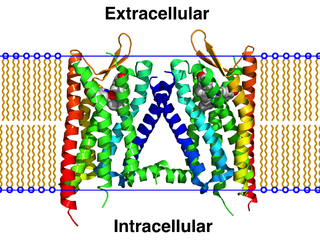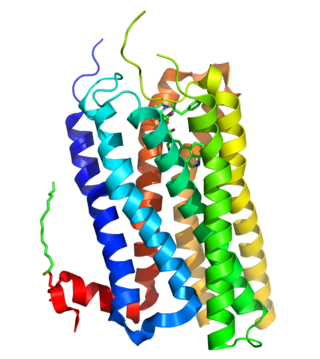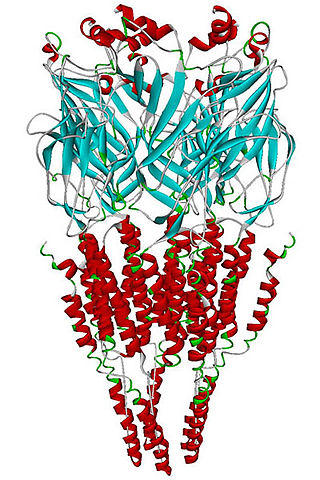Related Research Articles

An imidazopyridine is a nitrogen containing heterocycle that is also a class of drugs that contain this same chemical substructure. In general, they are GABAA receptor agonists, however recently proton pump inhibitors, aromatase inhibitors, NSAIDs and other classes of drugs in this class have been developed as well. Despite usually being similar to them in effect, they are not chemically related to benzodiazepines. As such, GABAA-agonizing imidazopyridines, pyrazolopyrimidines, and cyclopyrrones are sometimes grouped together and referred to as "nonbenzodiazepines." Imidazopyridines include:

The GABAA receptor (GABAAR) is an ionotropic receptor and ligand-gated ion channel. Its endogenous ligand is γ-aminobutyric acid (GABA), the major inhibitory neurotransmitter in the central nervous system. Accurate regulation of GABAergic transmission through appropriate developmental processes, specificity to neural cell types, and responsiveness to activity is crucial for the proper functioning of nearly all aspects of the central nervous system (CNS). Upon opening, the GABAA receptor on the postsynaptic cell is selectively permeable to chloride ions (Cl−) and, to a lesser extent, bicarbonate ions (HCO3−).
Sigma receptors (σ-receptors) are protein cell surface receptors that bind ligands such as 4-PPBP, SA 4503 (cutamesine), ditolylguanidine, dimethyltryptamine, and siramesine. There are two subtypes, sigma-1 receptors (σ1) and sigma-2 receptors (σ2), which are classified as sigma receptors for their pharmacological similarities, even though they are evolutionarily unrelated.

The κ-opioid receptor or kappa opioid receptor, abbreviated KOR or KOP for its ligand ketazocine, is a G protein-coupled receptor that in humans is encoded by the OPRK1 gene. The KOR is coupled to the G protein Gi/G0 and is one of four related receptors that bind opioid-like compounds in the brain and are responsible for mediating the effects of these compounds. These effects include altering nociception, consciousness, motor control, and mood. Dysregulation of this receptor system has been implicated in alcohol and drug addiction.
Melanocortin receptors are members of the rhodopsin family of 7-transmembrane G protein-coupled receptors.
Neurotensin receptors are transmembrane receptors that bind the neurotransmitter neurotensin. Two of the receptors encoded by the NTSR1 and NTSR2 genes contain seven transmembrane helices and are G protein coupled. Numerous crystal structures have been reported for the neurotensin receptor 1 (NTS1). The third receptor has a single transmembrane domain and is encoded by the SORT1 gene.
The galanin receptor is a G protein-coupled receptor, or metabotropic receptor which binds galanin.

The nociceptin opioid peptide receptor (NOP), also known as the nociceptin/orphanin FQ (N/OFQ) receptor or kappa-type 3 opioid receptor, is a protein that in humans is encoded by the OPRL1 gene. The nociceptin receptor is a member of the opioid subfamily of G protein-coupled receptors whose natural ligand is the 17 amino acid neuropeptide known as nociceptin (N/OFQ). This receptor is involved in the regulation of numerous brain activities, particularly instinctive and emotional behaviors. Antagonists targeting NOP are under investigation for their role as treatments for depression and Parkinson's disease, whereas NOP agonists have been shown to act as powerful, non-addictive painkillers in non-human primates.

The δ-opioid receptor, also known as delta opioid receptor or simply delta receptor, abbreviated DOR or DOP, is an inhibitory 7-transmembrane G-protein coupled receptor coupled to the G protein Gi/G0 and has enkephalins as its endogenous ligands. The regions of the brain where the δ-opioid receptor is largely expressed vary from species model to species model. In humans, the δ-opioid receptor is most heavily expressed in the basal ganglia and neocortical regions of the brain.

The bombesin receptor subtype 3 also known as BRS-3 or BB3 is a protein which in humans is encoded by the BRS3 gene.
Neuromedin U is a neuropeptide found in the brain of humans and other mammals, which has a number of diverse functions including contraction of smooth muscle, regulation of blood pressure, pain perception, appetite, bone growth, and hormone release. It was first isolated from the spinal cord in 1985, and named after its ability to cause smooth muscle contraction in the uterus.

Dopamine receptor D1, also known as DRD1. It is one of the two types of D1-like receptor family — receptors D1 and D5. It is a protein that in humans is encoded by the DRD1 gene.

5-Hydroxytryptamine receptor 2B (5-HT2B) also known as serotonin receptor 2B is a protein that in humans is encoded by the HTR2B gene. 5-HT2B is a member of the 5-HT2 receptor family that binds the neurotransmitter serotonin (5-hydroxytryptamine, 5-HT). Like all 5-HT2 receptors, the 5-HT2B receptor is Gq/G11-protein coupled, leading to downstream activation of phospholipase C.

Neuropeptide Y receptor type 2 (Y2R) is a member of the neuropeptide Y receptor family of G-protein coupled receptors, that in humans is encoded by the NPY2R gene.

Neuropeptide Y receptor type 5 is a protein that in humans is encoded by the NPY5R gene.

Metabotropic glutamate receptor 2 (mGluR2) is a protein that, in humans, is encoded by the GRM2 gene. mGluR2 is a G protein-coupled receptor (GPCR) that couples with the Gi alpha subunit. The receptor functions as an autoreceptor for glutamate, that upon activation, inhibits the emptying of vesicular contents at the presynaptic terminal of glutamatergic neurons.

SL651498 is an anxiolytic and anticonvulsant drug used in scientific research, with a chemical structure most closely related to β-carboline derivatives such as abecarnil and gedocarnil. It has similar effects to benzodiazepine drugs, but is structurally distinct and so is classed as a nonbenzodiazepine anxiolytic.

The alpha-7 nicotinic receptor, also known as the α7 receptor, is a type of nicotinic acetylcholine receptor implicated in long-term memory, consisting entirely of α7 subunits. As with other nicotinic acetylcholine receptors, functional α7 receptors are pentameric [i.e., (α7)5 stoichiometry].
Neuromedin S is a 36-amino acid neuropeptide found in the brain of humans and other mammals. It is produced in the suprachiasmatic nucleus of the hypothalamus and is related to neuromedin U. It is thought to be involved in regulation of circadian rhythm and also has appetite suppressant effects, as well as regulating the release of several other peptide hormones including vasopressin, luteinizing hormone, and oxytocin.

LY-487,379 is a drug used in scientific research that acts as a selective positive allosteric modulator for the metabotropic glutamate receptor group II subtype mGluR2. It is used to study the structure and function of this receptor subtype, and LY-487,379 along with various other mGluR2/3 agonists and positive modulators are being investigated as possible antipsychotic and anxiolytic drugs.
References
- ↑ Brighton PJ, Szekeres PG, Willars GB (June 2004). "Neuromedin U and its receptors: structure, function, and physiological roles". Pharmacological Reviews . 56 (2): 231–48. doi:10.1124/pr.56.2.3. PMID 15169928. S2CID 884735.
- ↑ Mitchell J, Maguire J, Davenport A (June 2009). "Emerging pharmacology and physiology of neuromedin U and the structurally related peptide neuromedin S". British Journal of Pharmacology. 158 (1): 87–103. doi:10.1111/j.1476-5381.2009.00252.x. PMC 2795236 . PMID 19519756.
- ↑ Peier A, Kosinski J, Cox-York K, Qian Y, Desai K, Feng Y, Trivedi P, Hastings N, Marsh DJ (July 2009). "The antiobesity effects of centrally administered neuromedin U and neuromedin S are mediated predominantly by the neuromedin U receptor 2 (NMUR2)". Endocrinology. 150 (7): 3101–9. doi:10.1210/en.2008-1772. PMC 2703546 . PMID 19324999.
- ↑ Meng T, Su HR, Binkert C, Fischli W, Zhou L, Shen JK, Wang MW (April 2008). "Identification of non-peptidic neuromedin U receptor modulators by a robust homogeneous screening assay". Acta Pharmacologica Sinica. 29 (4): 517–27. doi: 10.1111/j.1745-7254.2008.00769.x . PMID 18358099.
- ↑ Kajino M, Hinuma S, Tarui N, Yamashita T, Nakayama Y. Receptor regulators. European Patent EP 1559428 A1. Published 03.08.2005
- ↑ Liu JJ, Payza K, Huang J, Liu R, Chen T, Coupal M, Laird JM, Cao CQ, Butterworth J, Lapointe S, Bayrakdarian M, Trivedi S, Bostwick JR (July 2009). "Discovery and pharmacological characterization of a small-molecule antagonist at neuromedin U receptor NMUR2". The Journal of Pharmacology and Experimental Therapeutics. 330 (1): 268–75. doi:10.1124/jpet.109.152967. PMID 19369576. S2CID 7366636.